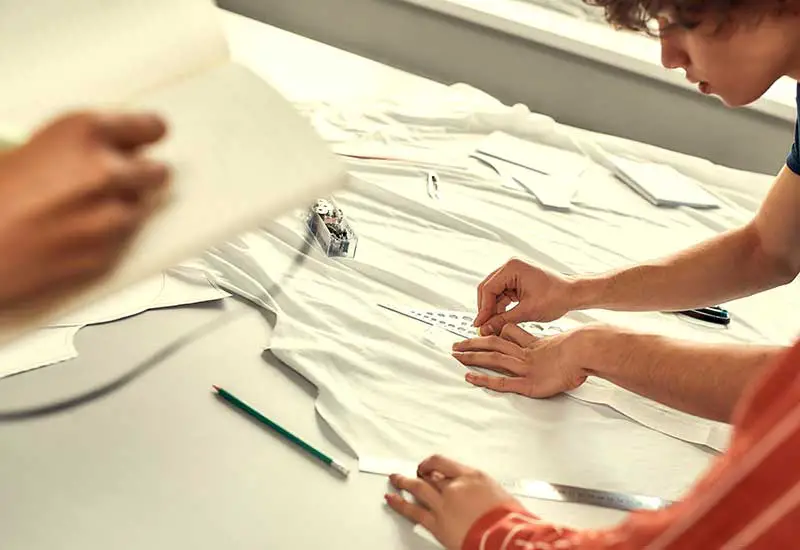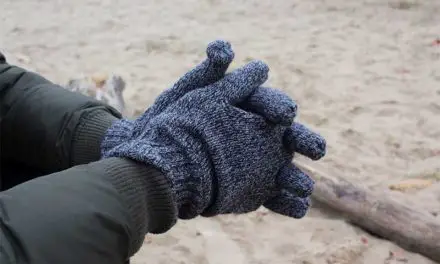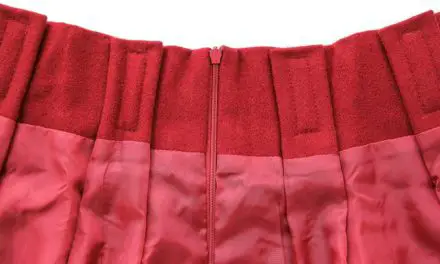One of the most common projects that hobby sewers take on is probably t-shirts. At its core, a t-shirt has very few pieces. There is a front, a back, two sleeves, and, neck binding. If you’re looking for a comprehensive tutorial on how to sew a t-shirt, then you’re in the right place!
The detailed instructions we have are beginner-friendly and you’ll learn everything, from creating your own pattern to adding the final touches. So let’s get started.
Table of Contents
Supplies You’ll Need
- Jersey cotton fabric for the T-Shirt body roughly 1 x 2 meters
- An optional strip of fabric for the neck binding
- Matching cotton thread
- A t-shirt that fits you well for making the pattern
- A good roll of plain paper for drawing your pattern
- Plenty of pins
- Tailor’s shears or a pair of sharp scissors
- Tailor’s chalk
- Pencil
- Ruler
- A seam ripper in case you make any mistake
Which fabric should I choose for my DIY t-shirt?
There are numerous fabrics you can choose when making a homemade t-shirt. Most people love working with that mid-weight jersey cotton since it is stretchy, quite easy to sew, and comfortable to wear. Nevertheless, it will still boil down to personal preference.
How To Make A T-Shirt Pattern
Instead of purchasing a pre-made t-shirt pattern online, you can actually make your own. Also, it’s okay if you don’t perfect the first on your first attempt.
If at the end of our how to sew a t-shirt tutorial, you find that the garment is a bit tight, simply add some width to your pattern and try again. Or add a bit of extra length if the arms are too short. You will likely make a couple of practices before getting the perfect pattern. But once you have, you can use it over and over again.
Step 1:
Get your favorite t-shirt. Make sure that it fits your body nicely. That means it is not too small or too big.
Step 2:
Turn your t-shirt inside out and lay it flat onto a large piece of plain paper. Smooth out the wrinkles so it lies as flat as possible. Do not stretch to avoid deforming the shape.
Step 3:
Use a pencil to trace around the edge of your t-shirt. Go along the sides, the shoulders, the back neckline, and the bottom. But make sure not to draw around the arms. Instead, fold the arms up and draw along the line of stitching that connects the arm to the body. You’ll be left with a kind of vest shape.
Step 4:
Cut out the body piece that you’ve just drawn. This will form the back piece of your DIY t-shirt. Use this pattern piece to cut another, identical piece. But this time, cut the neckline a little lower using your existing garment as a guide. Cut this second body piece out. This will serve as your front pattern piece.
Step 5:
Lie your t-shirt flat onto your paper again. This time, draw around one of the sleeves. Go around all three edges of the flat sleeve, and the curved seam line. The shape will give you half of your sleeve pattern.
To complete the pattern, simply draw a mirror image of the sleeve shape to extend it outwards. Then, cut out the full sleeve pattern piece.
Cut Out The Pattern Pieces
Step 1:
Lay your fabric over a flat surface. Make sure it doesn’t get any wrinkles, distortions, or stretched bits.
Step 2:
Place one of your paper pattern pieces on top and align it so that the stretch of the jersey fabric is across the width of your t-shirt. Do not pin your pattern pieces in place to avoid stretching them or introducing distortions. Instead, use sewing weights or some heavy books to hold them in place.
Step 3:
Draw around the edge of your t-shirt pattern pieces very carefully using a tailor’s chalk. Also, try not to pull or tug on your fabric as you do this.
Step 4:
Cut out the shape using a pair of sharp scissors or a tailor’s shears. Once you’ve cut them all out, you’ll end up with a front piece, back piece, and two arms.
Instructions On How To Sew A T-Shirt Together
Step 1:
Put the two t-shirt body pieces back to back. At this point, the wrong sides are facing out. Align them as neatly as possible and focus on the neckline and shoulders. Then, pin them in place along the shoulders at every 1 inch.
Step 2:
Sew along the pinned shoulder edges to join your two pattern pieces together and remove the pins as you go.
Step 3:
Afterward, open out the two pieces so they are only joined at the shoulders. Take one of your arm pattern pieces and find the center point of the curved side. Line this center point up to one of the shoulders and pin it in place, ensuring that the right sides facing in. This pin will be at the point that will lie on the very edge of the shoulder of your homemade t-shirt.
Step 4:
Pin the rest of the armhole. Beginning at the pin you have just attached, work outwards along the curved edge of the arm and pin it to the body piece.
Half of the arm piece will join the front body piece while the other half will join the back. Make sure that you are very careful at this step since it’s a little tricky to pin curved edges together.
Step 5:
Sew the pinned arm piece carefully to the body pieces, along the curve you have just pinned, and remove the pins as you go.
Repeat this for the other arm piece.
Step 6:
Lastly, sew the two side seams by first folding the back of your t-shirt together along the shoulder seam with the right sides facing in. Doing so will make the front and back neatly line up again.
Pin the sides together, beginning at the underarm and working your way down to the bottom edge. Sew in place, removing the pins as you go.

Adding The Neckline
Step 1:
Cut a strip of fabric at 4cm wide by about 45cm long.
Step 2:
Use a medium-hot iron to press the fabric strip flat. Then, fold the strip in half along the long edge carefully and neatly. Press this in place as well
Step 3:
Find the midpoint of the neck binding strip and then turn your garment the right way round. Line the midpoint of the neck binding with the midpoint of the neck hole, on the front of your t-shirt.
You must align the raw edges of the binding strip with the raw edge of the neck hole and pin them together in place.
Step 4:
Make a 10cm mark on the binding strip to one side of the pinned midpoint. Pin this marked point to the shoulder seam of the neck hole.
At this point, the length of the fabric between the pins should be shorter for the neck binding than it is for the neck hole.
Step 5:
Once you have the neckline pinned in two places, add more pins in-between the two existing pinned points carefully. You will then have to lightly stretch the neck binding as you pin so that it lines up against the neck hole without any gaps.
When you’re done, you’ll now have a quarter of the neckline pinned in place. Repeat this step for the other quarter of the neckline that sits on the front of your t-shirt.
Repeat this for the back piece so that the entire neckline is pinned in place.
Step 6:
Set your sewing machine to a zig-zag stitch and sew throughout the neck binding, removing the pins as you go. As you sew, make sure to gently stretch the neckline so that the binding is at a higher tension than the neck hole.
Step 7:
When you get to the back of the neckline, where the two ends meet, stop sewing. Remove any remaining pins and the two ends of the neckline. Next, lay them flat against each other with the right sides together, pin them, and sew in place using a straight stitch.
Trim any excess and then fold the neckline in half again. Then, simply sew this to your t-shirt similar to how you sewed the rest of the neckline using a zig-zag stitch.
Adding The Finishing Touches
You’re almost done with how to sew a t-shirt! There are just a few more steps you need to make before you can wear it.
Step 1:
Put your homemade t-shirt on and let the fabric drop naturally. Make sure that it is not bunched up in any places. Make a small mark on the waist area using a tailor’s chalk at a length you prefer to cut it to.
Do the same for each of the arms.
Step 2:
Take your t-shirt off and locate the marks you just made. Add an extra 3 to 4 seam allowance on all points and then cut off any excess fabric.
Step 3:
Beginning at the waist area, fold the raw edge over by roughly 1 to 2 cm. Then, fold it over either outwards or inwards another 1 to 2 cm to hid the raw edge.
Next, sew over the folded edge beginning at the side of your t-shirt. Keep sewing around the waist, until you loop back on yourself. If the fit is a little loose, you may apply a straight stitch for this step. But if the fit is tighter, use a zig-zag stitch.
Keep in mind that the most important thing during this step is to make sure that your fabric does not stretch as you sew it.
Step 4:
Repeat the exact same process for each of the arms.
Congratulations! Your t-shirt is finished. By following these detailed steps on how to sew a t-shirt, you’ll be able to make one for yourself or as a gift to your loved ones at any time.





